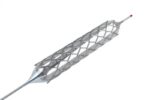Original title: Impact of an invasive strategy on five years outcomein men and women with Non-ST-Elevation Acute Coronary Syndromes. Reference: Joakim Alfredsson et al. Am Heart J. 2014;Epub ahead of print. This meta-analysis included patients with non-ST-elevation acute coronary syndrome (NSTE ACS) from randomized studies FRISC II, ICTUS and RITA 3 and compared the routine invasive strategy<a href="https://solaci.org/en/2014/07/29/benefits-at-5-years-of-routine-invasive-strategy-in-non-st-elevation-acute-coronary-syndromes/" title="Read more" >...</a>
Reduced risk of acute, late and very late thrombosis with new generations of DES versus BMS in the acute myocardial context
Original title: Stent thrombosis in new-generation drug-eluting stents in patients with STEMI undergoing primary PCI: a report from SCAAR. Reference: Sarno G et al. J Am Coll Cardiol. 2014;Epub ahead of print. This study evaluated 34147 consecutive patients suffering acute myocardial infarction with ST-segment elevation included in the SCAAR registry (Swedish Coronary Angiography and Angioplasty Registry) undergoing primary<a href="https://solaci.org/en/2014/07/11/reduced-risk-of-acute-late-and-very-late-thrombosis-with-new-generations-of-des-versus-bms-in-the-acute-myocardial-context/" title="Read more" >...</a>
Superficial Femoral Artery In-Stent Restenosis with Drug Eluting Balloon: 2 Year Follow Up.
Original title: Drug-Eluting Balloons for the Treatment of the Superficial Femoral Artery In-Stent Restenosis. 2-Year Follow-Up. Reference: Vittorio Virga et al. J Am Coll Cardiol Intv 2014;7:411–5. Although the use of the self-expanding nitinol stent has improved angioplasty outcomes in femoropopliteal territory, restenosis remains a challenge still affecting at least 25% of the population in the first year.<a href="https://solaci.org/en/2014/07/08/superficial-femoral-artery-in-stent-restenosis-with-drug-eluting-balloon-2-year-follow-up/" title="Read more" >...</a>
SYNTAX study final monitoring at 5-years
Original title: Coronary artery bypass grafting vs. percutaneous coronary intervention for patients with three-vessel disease: final five-year follow-up of the SYNTAX trial. Reference: Eur Heart J. 2014 May 21. pii: ehu213. (Epub ahead of print). The SYNTAX study was one of the largest randomized clinical studies comparing long-term results of angioplasty versus surgery in multivessel disease and /or<a href="https://solaci.org/en/2014/07/04/syntax-study-final-monitoring-at-5-years/" title="Read more" >...</a>
Best ejection fraction using Metoprolol as pretreatment in acute myocardial infarction
Original title: Long-Term Benefict of Early Pre-Reperfusion Metoprolol Administraction in Patients With Acute Myocardial Infaction. From the METOCARD-CNIC Trial. Reference: Gonzalo Pizarro et, al. J Am Coll Cardiol 20141;63:2356-62 The anterior infarction with ST- segment elevation has a high morbidity and mortality, both in the acute phase as well as after the presence of heart failure, arrhythmias<a href="https://solaci.org/en/2014/06/25/best-ejection-fraction-using-metoprolol-as-pretreatment-in-acute-myocardial-infarction/" title="Read more" >...</a>
Cohort with left main coronary injury of SYNTAX. Final monitoring at 5 years.
Original title: Five-year outcomes in patients with left main disease treated with either percutaneous coronary intervention or coronary artery bypass grafting in the synergy between percutaneous coronary intervention with taxus and cardiac surgery trial. Reference: Morice MC et al. Circulation. 2014 Jun 10;129(23):2388-94. Current guidelines recommend CABG as the strategy of choice for treating lesions of<a href="https://solaci.org/en/2014/06/19/cohort-with-left-main-coronary-injury-of-syntax-final-monitoring-at-5-years/" title="Read more" >...</a>
Orbital Atherectomy improves calcified lesions treatment outcomes
Original title: Pivotal Trial to Evaluate the Safety and Efficacy of the Orbital Atherectomy System in Treating de Novo, Severely Calcified Coronary Lesions (ORBIT II) Reference: Jeffrey Chambers, et al. JACC Intervention 2014;7:510-8 Severely calcified coronary lesions, traditionally associated to difficult or impossible stent implantation, asymmetric stent expansion, higher post procedural events rate, more restenosis, more lesion revascularization,<a href="https://solaci.org/en/2014/06/02/orbital-atherectomy-improves-calcified-lesions-treatment-outcomes/" title="Read more" >...</a>
Severe coronary calcification is a predictor of coronary events in acute coronary syndromes
Original title: Ischemic Outcomes After Coronary Intervention of Calcified Vessels in Acute Coronary Syndromes. Pooled Analysis From the HORIZONS and ACUITY Trials. Reference: Philippe Généreux, et al. J Am Coll Cardiol 2014;63:1845-54 Calcification of the arteries has always been a challenge and a generator of problems during coronary angioplasty, but its impact on acute coronary syndromes has not<a href="https://solaci.org/en/2014/05/21/severe-coronary-calcification-is-a-predictor-of-coronary-events-in-acute-coronary-syndromes/" title="Read more" >...</a>
Increased security with bivalirudin than with heparin alone in patients without ST segment.
Original title: Heparin monotherapy or bivalirudin during percutaneous coronary intervention in patients with non-ST-segment elevation acute coronary syndromes or stable ischemic heart disease: results from the Evaluation of Drug-Eluting Stents and Ischemic Events registry. Reference: Bangalore S et al. CircCardiovascInterv. 2014;Epub ahead of print. Bivalirudin compared to unfractionated heparin as monotherapy is associated with a lower risk of<a href="https://solaci.org/en/2014/05/14/increased-security-with-bivalirudin-than-with-heparin-alone-in-patients-without-st-segment/" title="Read more" >...</a>
The length of the stent is not an event predictor with the new generation of DES. It is the end of the Spot stenting?
Original title: Impact of the Stent Length on Long-Term Clinical Outcomes Following Newer-Generation Drug-Eluting Stent Implantation. Reference: Ik Jun Choi et al. Am J Cardiol 2014;113:457-464. Completely cover the lesion with a sufficiently long stent has been the preferred strategy that emerged from drug-eluting stents (DES). However, for the first-generation DES stent length has been a predictor of<a href="https://solaci.org/en/2014/02/20/the-length-of-the-stent-is-not-an-event-predictor-with-the-new-generation-of-des-it-is-the-end-of-the-spot-stenting/" title="Read more" >...</a>









